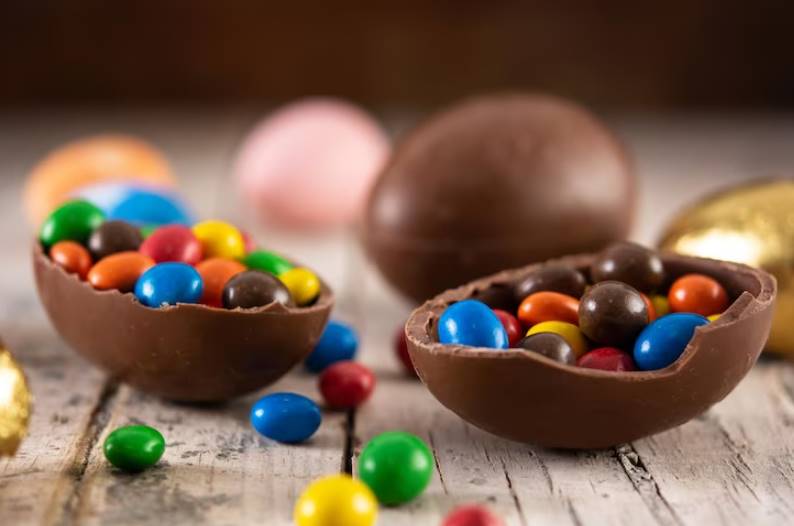Easter is one of the most important Christian celebrations, where they commemorate the resurrection of Jesus Christ. However, Easter also brings along a different kind of excitement – chocolate eggs and Easter bunnies. But have you ever wondered why Easter chocolates taste different from the regular ones? In this article, we will unravel the mystery behind the taste of Easter chocolates that will make you appreciate your Easter treats even more.
Have you ever noticed that Easter chocolates have a distinct taste to them? This is because chocolatiers use specific cocoa blends and add different flavorings to the chocolate mixture, producing a unique taste.
The quality of cocoa beans used in Easter chocolates is usually superior to the ones used in regular chocolates, which gives it a richer and more indulgent flavor. Moreover, the different flavorings added to the chocolate mixtures, such as vanilla, spice, and fruit oils, contributes to the unique taste of Easter chocolates.

Unique Forms and Shapes of Easter Chocolates
Easter chocolates come in a variety of shapes and forms, such as eggs, bunnies, chicks, and other spring-themed designs. The molds used to create these creatively shaped chocolates can also influence the taste of the chocolate.
For example, ornamental Easter eggs might have a firmer shell or a softer center, which alters the overall taste of the chocolate. The combination of a unique shape and an exquisite taste is what separates Easter chocolates from the rest of the chocolates out there.
The Role of Palm Oil in Easter Chocolate
Palm oil is a common ingredient in many types of chocolate, including Easter chocolate. While this ingredient is used to improve the texture and consistency of chocolate, it can also affect the taste. Palm oil has a higher melting point than cocoa butter, which means that it can create a different mouthfeel when consumed. Additionally, palm oil has a slightly different flavor profile than cocoa butter, which can be detected in some types of chocolate.
- Palm oil can improve the texture of chocolate but affects its taste as well.
- Palm oil has a higher melting point than cocoa butter which can change how the texture of chocolate feels in the mouth.
- Palm oil can result in a slightly different flavor profile that can be distinguished in some chocolates.
The Use of Artificial Flavors in Easter Chocolate
To create Easter-themed chocolate flavors, many chocolate makers use artificial flavors. While this can make for a fun and unique taste experience, it can also impact the overall flavor profile of the chocolate. Artificial flavors can sometimes overpower the natural taste of cocoa, leading to a less complex and nuanced chocolate flavor.
- Easter chocolate makers use artificial flavors to create unique chocolate.
- Artificial flavors can impact the overall flavor profile of chocolates.
- Artificial flavors can sometimes lead to a less complex and nuanced chocolate flavor, overpowering the natural taste of cocoa.
The Addition of Other Ingredients
Easter chocolates often contain additional ingredients like milk, vanilla, sugar, and oils. These elements add flavor and texture to the chocolate. The combination of these ingredients gives Easter chocolate its sweet and creamy taste.
- Milk chocolate is the most popular type of chocolate used in Easter chocolates.
- Adding vanilla to chocolate enhances its flavor by giving it a smooth and warm taste.
- Chocolate makers also use cocoa butter and other oils to create a smooth and glossy texture in Easter chocolates.
The Quality of Ingredients
Another factor that contributes to the unique flavor of Easter chocolate is the quality of ingredients used in its production. Many chocolatiers use higher-quality cocoa beans for their Easter eggs than they do for other types of chocolates.
This results in a richer flavor as well as a smoother texture. In addition, some chocolatiers add additional ingredients such as nuts or dried fruits to their Easter eggs for added flavor and texture.
The Role of Packaging in Preserving the Aroma and Taste of Easter Chocolates
Packaging plays a crucial role in preserving the aroma and taste of Easter chocolates. Chocolate makers take special care to wrap their Easter chocolates in high-quality materials that maintain the freshness and flavor of the chocolates.
For instance, the wrapping material is vacuum-sealed with an airtight seal to lock in the aroma and taste of the chocolate. This special packaging ensures that the Easter chocolates taste delicious even several weeks after the holiday is over.
Easter Chocolates and the Role of Emotions
Why do Easter chocolates taste so special and delicious? One reason could be the emotional connection between Easter and chocolate. Easter is celebrated with close friends and family, and Easter chocolates play a significant role in strengthening those bonds, emphasizing the sweetness of Easter memories, and creating more memorable moments.
These moments of association and connection often translate into the perceived tastiness of Easter chocolates, making even the most ordinary chocolate taste exceptional.
Health Benefits of Easter Chocolates
Surprisingly, Easter chocolates can actually be good for your health too. It’s primarily due to the presence of cocoa flavonoids in the chocolate, which are known to have antioxidant properties. Eating moderate amounts of dark chocolate can reduce the risk of heart disease, improve blood pressure, and reduce inflammation. So, indulging in your favorite Easter chocolates can benefit your health too!
Conclusion
Easter chocolates have an intriguing history and flavor that sets it apart from regular chocolates. The science of flavoring, unique molds, and special packaging plays a crucial role in creating the unforgettable Easter chocolate experience.
The emotional connection between Easter and chocolate also elevates the perceived taste of Easter chocolates, making them taste even better. In addition, the health benefits of cocoa flavonoids in Easter chocolates make them an ideal treat for this special holiday. Whether it’s a bunny, egg or chick-shaped chocolate, Easter chocolates never fail to bring a smile to our faces and create heart-warming memories that last a lifetime.
FAQs – Why Does Easter Chocolate Taste Different?
1. Q: Why does Easter chocolate taste different from regular chocolate?
A: Easter chocolate typically tastes different due to a combination of factors including the type of cocoa used, the ratio of cocoa to other ingredients, and the manufacturing process. Seasonal chocolates like Easter eggs and bunnies are often made using a different recipe or lower-quality cocoa compared to premium chocolate bars, which can result in a distinct flavor.
2. Q: Does the shape of Easter chocolate affect its taste?
A: The shape of Easter chocolate can indeed influence its taste. When chocolate is molded into different shapes like eggs or bunnies, the thickness may vary, which can affect how quickly it melts in your mouth. Thinner chocolate melts faster, releasing its flavors more quickly, while thicker chocolate takes longer to melt, affecting the overall taste experience.
3. Q: Do additives or fillings contribute to the different taste of Easter chocolate?
A: Yes, additives and fillings can significantly impact the taste of Easter chocolate. Many seasonal chocolates contain added flavors, colors, or sweeteners, which can alter the taste profile. Additionally, fillings such as caramel, marshmallow, or fruit-flavored creams can contribute to the unique taste of Easter chocolates.
4. Q: Is there a difference in quality between Easter chocolate and other chocolates?
A: The quality of Easter chocolate can vary widely depending on the brand and price point. Some manufacturers may use lower-quality cocoa or higher amounts of sugar and other fillers to cut costs for seasonal products. However, many high-quality chocolate brands also produce Easter chocolates using their standard recipes, resulting in a product that tastes just as good as their regular offerings.
5. Q: Are there any health concerns related to eating Easter chocolate?
A: As with any chocolate or sweet treat, moderation is key when consuming Easter chocolate. Consuming excessive amounts of sugar can lead to various health issues, including weight gain and tooth decay. Additionally, some Easter chocolates may contain artificial colors or flavors that can cause allergic reactions in sensitive individuals. It’s essential to check the ingredients list and enjoy these seasonal treats in moderation.


















